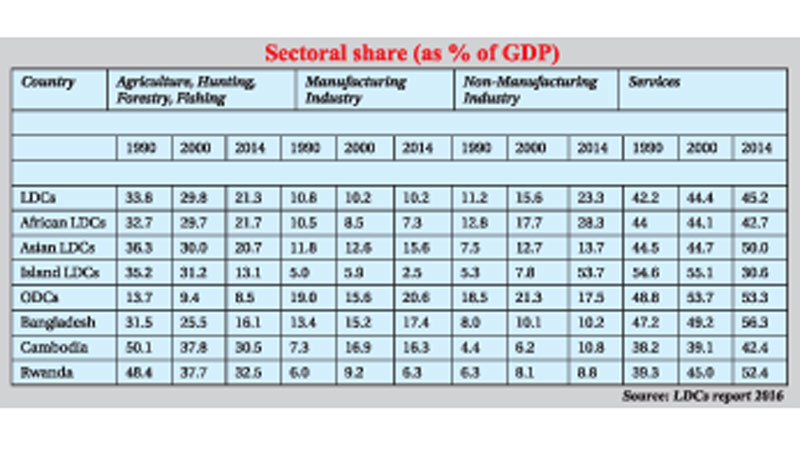Published in The Independent on Saturday, 31 December 2016
Rise in manufacturing sector’s contribution to GDP stressed
The Least Developed Countries (LDCs) Report 2016, prepared by The United Nations Conference on Trade and Development (UNCTAD), has placed Bangladesh below other developing countries in terms of the manufacturing sector’s contribution to GDP, said Towfiqul Islam Khan, a research fellow of the Centre for Policy Dialogue (CPD).
Khan said this in his keynote address at an event organised to release the report recently.
He also said Bangladesh would graduate from the LDC category by 2024, stressing that the transition, which must be smooth and sustainable, was going to be pivotal.
 The UNCTAD report shows that the number of LDCs has risen from 25 in 1971 to 48 at present. It also mentions that only 16 countries are projected to graduate by 2025.
The UNCTAD report shows that the number of LDCs has risen from 25 in 1971 to 48 at present. It also mentions that only 16 countries are projected to graduate by 2025.
According to the World Bank classification, there are two classes of middle-income countries, namely lower-middle and upper-middle ones.
The basis of taxonomy consists of three criteria, 12 different structural indicators and an indicator for income. The three criteria are: income, human assets index (HAI) and economic vulnerability index (EVI).
Quality of institutions, peace and social stability, economic and social planning, emphasis on infrastructure and education, and prudent and forward-looking macroeconomic policies are the key drivers of graduation, says the report.
It also says Bangladesh may continue to enjoy LDC preferential treatment up to 2027, even if it graduates in 2024, to help with its smooth transition. It also mentions that graduation alone is not enough as LDCs require graduation with momentum while laying the foundations for subsequent development.
Khan said that momentum graduation would be very important for Bangladesh to keep up the sustainable growth.
The keynote speaker also spoke on the sectoral share as the percentage of Gross Domestic Product (GDP) among all the LDCs.
The agriculture, forestry and fishing sector’s contributions to the GDP in 1990, 2000 and 2014 were 31.5, 25.5 and 16.1 per cent, respectively. This displays a gradual decrease, which is a good sign indicating that other sectors’ contribution to the GDP has been increasing steadily.
Many people in Bangladesh were still engaged in agriculture, and the biggest challenge would be to create more jobs in other sectors to contribute to the GDP, the keynote speaker explained.
In the manufacturing sector, the sectoral shares in 1990, 2000 and 2014 were 13.4, 15.2 and 17.4 per cent, respectively.
Bangladesh is well placed in comparison other LDCs, but its manufacturing sector’s share of the GDP is low compared to other developing countries. Manufacturing was the only way to make the country graduate to the next level, Khan said.
In the service sector, Bangladesh has improved and contributed a lot over the last 25 years.
In 1990, 2000 and 2014, the sectoral shares were 47.2, 49.2 and 56.3 per cent, respectively.
The service sector trend shows that there has been an increase in the share of the service sector in the GDP composition of Bangladesh over the last two decades.
UNCTAD’s LDC report suggested a couple of things—one is to increase the fiscal policy of the government comprising improved tax systems, and diversification of revenue sources and addressing illicit financial flows.
Khan suggested improving the tax structure to boost the government’s revenue.
The tax-GDP ratio of Bangladesh was close to 10 per cent, but it was not sufficient because the Organisation for Economic Co-operation and Development (OECD) average happened to be 19.5 per cent, he noted.
Khan also suggested some long-term strategies over the next decade for capacity development.
Presently, the CPD has been doing research to find five strategies that Bangladesh could follow for the next decade till its graduation, said CPD executive director Prof. Mustafizur Rahman.



